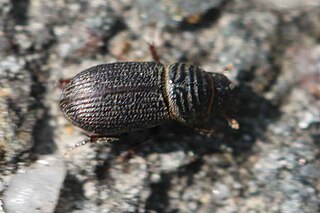
The leatherjacket fish or leather jack, Oligoplites saurus, is a species of jack in the family Carangidae. Leather jack may also refer to other members of the Carangidae, such as the pilot fish. The largest are about a foot long.

The Arnhem leaf-nosed bat is a species of bat in the family Hipposideridae. It lives in the sandstone areas of Kakadu National Park.
Copelatus inornatus is a species of diving beetle. It is part of the genus Copelatus in the subfamily Copelatinae of the family Dytiscidae. It was described by Sharp in 1882.

Elmidae, commonly known as riffle beetles, is a family of beetles in the superfamily Byrrhoidea described by John Curtis in 1830. Both adults and larvae are usually aquatic, living under rocks in fast-flowing shallow areas of streams, such as riffles, feeding on algae and biofilms. There are more than 150 genera and 1,500 described species in Elmidae. The oldest record of the group is Cretohypsilara from the Cenomanian aged Burmese amber.
Nodocapitus is a genus of velvet worm in the Peripatopsidae family. N. formosus is found in Queensland, Australia, N. inornatus is found in New South Wales, and N. barryi is found in both of these states.

Melolonthini is a tribe of scarab beetles in the family Scarabaeidae. There are over 200 genera in Melolonthini, occurring worldwide; there are over 300 species in North America alone.
Aradus inornatus is a species of flat bug in the family Aradidae. It is found in North America.
Lucifotychus is a genus of ant-loving beetles in the family Staphylinidae. There are about 19 described species in Lucifotychus.
Gronocarus autumnalis, the lobed spiny burrowing beetle, is a species of scarab beetle in the family Scarabaeidae. It is found in North America.
Gronocarus is a genus of May beetles and junebugs in the family Scarabaeidae. There are at least three described species in Gronocarus.
Condylostylus inornatus is a species of long-legged fly in the family Dolichopodidae.

Scytonotus is a genus of flat-backed millipedes in the family Polydesmidae. There are about 17 described species in Scytonotus.

Ochthebius is a genus of minute moss beetles in the family Hydraenidae. There are at least 460 described species in Ochthebius.

Thanatophilus is a genus of carrion beetles in the family Silphidae. There are about 12 described species in Thanatophilus.
Althos is a genus of leaf-footed bugs in the family Coreidae. There are more than 20 described species in Althos.

Rhyssemus is a genus of aphodiine dung beetles in the family Scarabaeidae. There are more than 160 described species in Rhyssemus.
Acinopterus is a genus of leafhoppers in the family Cicadellidae. There are more than 30 described species in Acinopterus.
Trischidias exigua, the trischidias exiguus, is a species of typical bark beetle in the family Curculionidae. It is found in North America.

Cissites is a genus of blister beetles in the family Meloidae. There are at least four described species in Cissites.
Cryptognatha nodiceps, known generally as the coconut scale predator or sugarcane scale predator, is a species of lady beetle in the family Coccinellidae; it is found in the Caribbean region, North America, and Oceania, having been introduced to various countries in an attempt to provide biological pest control of the coconut scale.








